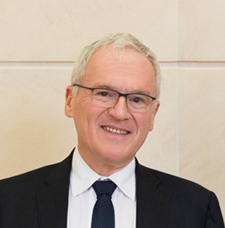
Low-carbon electrolytic hydrogen: a win-win for climate and energy system integration
In these times of uncertainty, where one emergency chases another, a necessity remains: CO emissions must be drastically reduced. The energy sector is at the crossroads of climate mitigation, economic recovery and technological innovation. In this perspective, low carbon hydrogen produced by electrolysis is a needed complement of direct electrification and is essential to decarbonise key segments of transport and industry.
Indeed hydrogen could play a major role in achieving carbon neutrality of the continent by 2050. Since it is expensive and not easy to produce in a way that does not emit CO2, it should be primarily used in sectors where no other solutions are available, such as hard-to- abate industrial and transport sectors.
Hydrogen is widely regarded as a cutting-edge technology and the EU leads the way.
50 to 60% of the ecosystem of hydrogen start-ups are based in Europe 1 . Not only has the European Commission presented an ambitious European Hydrogen Strategy (in July 2020) but many Member States, such as France, Germany, Spain and the Netherlands, aim at integrating hydrogen into their energy future.
However, less than 0.1% of the hydrogen produced in Europe today comes from renewable or low-carbon electricity. At odds with the enhanced EU climate targets 2 , 95% of this hydrogen is of fossil origin and emits 10Kg of CO2 per Kg of hydrogen produced. In France, the manufacture of fossil fuel-based hydrogen is responsible for the emission of 11.5 Mt of CO2, i.e. 3% of national emissions 3. It is high time to replace it by low carbon hydrogen. In line with our ‘raison d’être’ in support of a CO2-neutral future, EDF is developing a new ally to electrification: low-carbon hydrogen produced by electrolysis.
As soon as electricity emits less than 200 gCO2/kWh, electrolysis reduces emissions compared to fossil hydrogen. Nevertheless, electricity-based H2 is currently 2.5 times more expensive than fossil hydrogen. Closing this price gap will require financial support in the first years on both the production side and on the demand side. It is challenging, but we believe that the EU, with its strong industrial basis, has what it takes to build a thriving hydrogen industry by creating joint investment projects throughout the value chain. Europe is already a leading electrolyser producer with 25–30% of the global market share.
EDF wants to support further growth in this area and that is the reason why the group invested in McPhy, a leading electrolyser manufacturer aiming at deploying a giga factory in the EU.
In addition, the cost of electrolysis will decrease dramatically and, at the end of the day, we won’t need dedicated funds anymore if we plan a phase-out of all fossil fuels and have a direct substitution of clean H2 in place of fossil H2.
I am truly convinced that it is possible to bring industrial partners around the table to identify barriers and solutions, to kick off projects in the field of hydrogen, with an open discussion with policy makers. This is the reason why EDF actively participates in the industrial committee of the European Hydrogen Council and in the new European Clean Hydrogen Alliance which is currently being launched by the European Commission. With my fellow co-chairs of the round table on hydrogen production, we aim at identifying the bottlenecks which slow down projects with a view to contributing to a robust EU policy framework.
With a sound yet flexible regulatory framework and sufficient financial support to kick start this nascent industry, hydrogen growth, technology innovation and ample employment opportunities can be unleashed. This can contribute to the EU post-Covid recovery by locating major parts of the supply chain in Europe rather than betting extensively on imports. What is at stake here is the development of large amounts of low carbon hydrogen. It is indeed crucial that CO2 emissions guide policy making and upcoming support measures.
CO2 emissions across the production life cycle must give clarity and transparency to both investors and consumers.
To swiftly deliver significant volumes in a cost-effective way, we also see a key role for electrolysers set up close to the consumption areas and connected to low carbon power grids as this allows the swift deployment of projects and a high number of production hours while reducing transport costs. Imports can be part of the picture but when walking away from fossil fuels the EU should seize the opportunity of reinforcing its energy sovereignty and resilience. To enable this grid connected production of hydrogen, it is critical that the EU policy frameworks enables traceability and transparency, for instance the system of guarantees of origin could be strengthened/ improved to enable the certification of both renewable and low-carbon hydrogen. For this purpose, the EU funded Certif’HY project is a GO system readily scalable.
As the first producer of renewables in Europe, EDF supports the key role of green hydrogen produced with renewable electricity which is at the core of the EU Hydrogen Strategy. Betting on the massive deployment of electrolysis projects is a unique opportunity to find synergies, flexibility and to enhance energy system integration. I am personally convinced that low-carbon and renewable electrolytic hydrogen is a win-win for decarbonisation. Not only does it contribute to fight against climate change, but it can also boost economic recovery while putting the European industry at the forefront of a major technological deployment.
_____________________________________________________________________________________
1 Material economics (2020), Mainstreaming green hydrogen in Europe, commissioned by Breakthrough Energy
2 At least 55% less greenhouse gas emissions by 2030, compared to 1990.
3 French Ministry of Ecological and Solidarity Transition – Plan de déploiement de l’hydrogène pour la transition énergétique https://www.actu- environnement.com/media/pdf/news-31396-plan- hydrogene-ministere-transition-energetique.pdf




